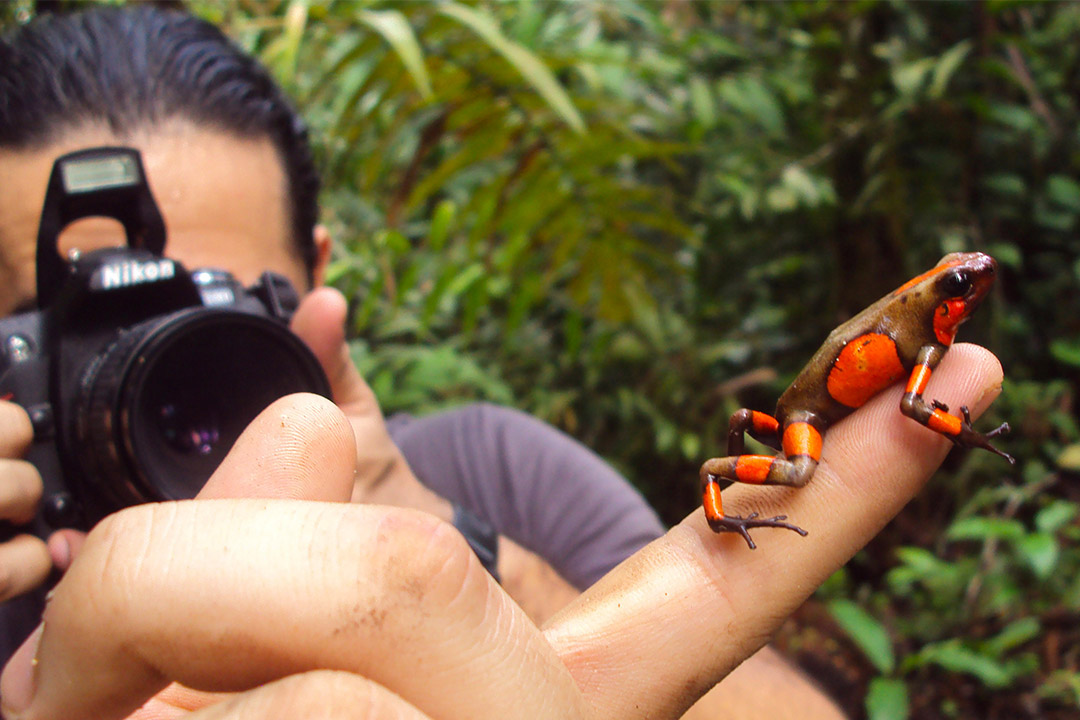
Mutated frog gene repels predators
The incredible colour patterns of Colombian dart frogs have long been a mystery, but now University of Saskatchewan researchers have identified the gene responsible for the black blobs and stripes that make the colours stand out.
By Federica GiannelliPost-doctoral researcher Andrés Posso-Terranova and his former supervisor José Andrés have found evidence that a single gene called MC1R controls the deep black color on the skin of these poisonous frogs. The researchers have found that the disruption of the gene is responsible for the black blobs and stripes. Their results have been published this week in the international journal Evolution.
“We knew the same gene stimulates the production of black pigment in other animals, but it’s also responsible for camouflage in mice and red hair in humans,” said Andrés, U of S biology professor. “There was no evidence of a correlation with coloration of frogs until now.”
The black patterns provide a sharp contrast to the dart frogs’ bright colours—red, yellow and orange—to send a highly detectable warning signal to predators such as snakes that the frogs are toxic, much like the coloring of wasps and bumblebees.
“These warning patterns are very effective and they are easily learned by predators,” said Posso-Terranova.
Dart frogs, traditionally used by Colombian Indigenous hunters to obtain poison for blowgun darts, make their powerful poison by eating toxic bugs. The poison is only dangerous to humans if it enters their bloodstream.
Deep in one of the wettest jungles of the Colombian Chocó province, the researchers photographed more than 300 frogs to classify them and collected genetic samples on over 90. Back at the U of S, they used state-of-the-art DNA technology to screen more than 15,000 genes that could be associated with coloration.
The researchers’ surprising discovery was that unrelated species of frogs in the north and the south of the province show mutations of the MC1R gene in the same DNA region, explaining why the frogs share similar black patterns even if they are not close relatives and live hundreds of kilometers apart.
“These mutations associated with black colour show the footprints of natural selection,” said Andrés. “It confirms that dark patterns are beneficial for frogs’ survival, so it has been passed down through generations.”
As a child growing up in Colombia, Posso-Terranova said there were so many frogs in his backyard but he has witnessed how fast they are disappearing due to global warming and a changing environment.
He cautions more research is needed, but hopes his project may help the Colombian government develop strategies to protect endangered frogs.
The frog study, funded by the federal agency NSERC and a Colciencias grant from the Colombian government, also found evidence that there are at least three endangered species, instead of the two identified in a 1976 study.
Conducting research in a country with an unstable socio-political situation wasn’t easy.
“Only thanks to recent peace negotiations between guerrilla groups and the Colombian government is it possible for scientists to access areas once off-limits,” said Posso-Terranova.
Federica Giannelli is a graduate student intern in the U of S research profile and impact unit.
This article first ran as part of the 2017 Young Innovators series, an initiative of the U of S Research Profile and Impact office in partnership with the Saskatoon StarPhoenix.

